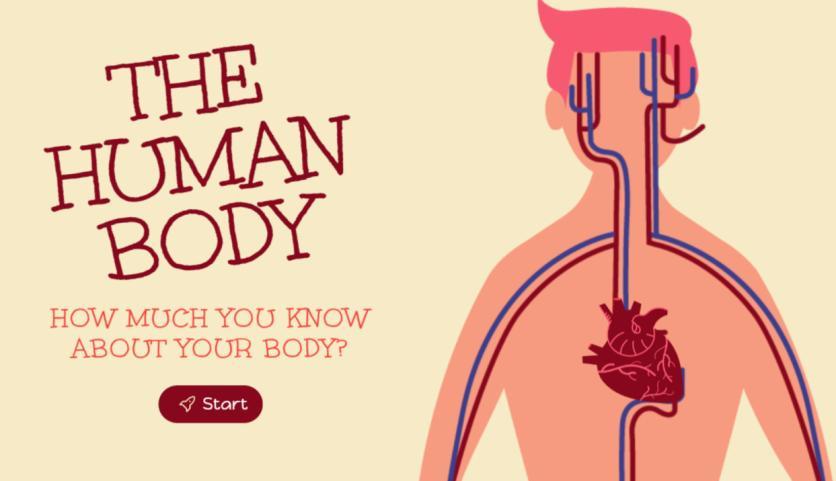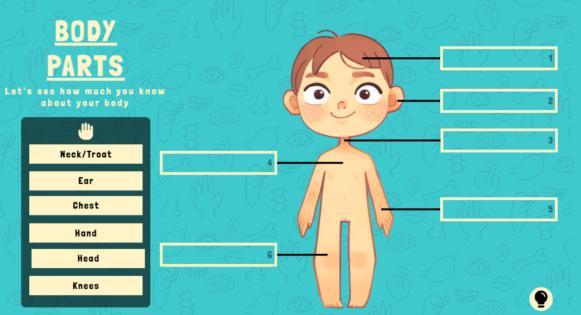Hybrid learning guide
The human body and its systems
Sixth grade
WH AT IS OUR GOAL?
Learn about the purpose behind the creation of our learning guide.
Our goal
Teaching science to children, adolescents, and adults can be challenging due to the complexity of the concepts, the availability of resources, and the difficulty of engaging students.
This learning guide aims to provide an engaging and enjoyable science lesson where students can learn about the human body.
The guide is specifically designed for sixth graders in a face-to-face classroom setting.
The learning guide is also designed following the principles of the content and language integrated learning (CLIL).
CLIL can promote the development of critical thinking skills” Rozo (2022)
THE LEARNNG GUIDE
We will explore the different stages, resources, and time required to complete the learning guide, as well as adaptations for various settings.
The Learning Guide Explained
The learning guide is divided into four main stages: presentation, practice, production, and assessment.
The main topic of the guide is the human body and its systems, and it was specifically designed for sixth graders in a face-to-face environment.
To create it, the author used Genially to develop an interactive, intuitive, and fun presentation.
The following chart provides a breakdown of the activities designed for each stage.
Stage Activity
Presentatio
n
Practice
• Warm up – What do they do?
• Theme presentation –Genially
• What did I learn about my body – Questionnaire
• Can you name these parts of the body? - Game
Production • Body in action –Pantomime
• How do I take care of my body? - Group Poster
Assessment
• Body basics – Crossword
• My body – Reflection
The learning guide was designed with a face-to-face environment in mind. However, it can also be used in a digital setting, allowing students to access multiple resources to complement their learning. Students can also self – pace the learning experience.
Didactics of sciences
HOW TO USE THIS GUIDE
Learn how to effectively use this learning guide in various environments, with varying levels of technological integration.
When using CLIL you need to focus on Content rather than language. Rozo (2022)
Applications Considerations
We will discuss some methodological considerations for using this learning guide in faceto-face, online, or hybrid learning environments. The following chart includes a breakdown on the methodology for each stage.
Activity
Warm up –What do they do?
Methodology
Teacher will project the pictures and ask question such as who are they? What do they do? How do they use their bodies for their jobs?
Modifications
Face to face environment: Print the pictures paste them on the board. Choose pictures from a local newspaper.
Online environment: Invite students to post their answer in the platform use for the course.
Topic presentation – Genially
What did I learn about my body –Questionnaire
The teacher will project the presentation using a projector or a digital board. Along the presentation they are questions, exercises and videos that support the main content.
The activity will be projected and students that want to participate will answer the questions proposed.
Face to face environment: It can be used as study material for the teacher.
Online environment: Students can review it ahead of time and bring questions to the session.
Face to face environment: Print the analog questionnaire that contains the questions, cut them and assigned two questions to a group students. Or write the questions on posters and paste them on the board.
Online environment: Allow students to share their screens and share their attempts. Can you name these parts of the body?Game
Project the game. Students can participate freely or to make it more engaging you can allow teamwork. This is a good moment to clarify vocabulary.
Body in action – Pantomime
After students have form their teams ask one member of the team to come close to choose a flashcards with the action. Make sure to set rules before starting.
Face to face environment: Draw an outline of the body. Ask students to try to point or draw the parts of the body you mention.
Online environment: Ask students to share their screens or modify the game to visualize performance. Use this information to provide feedback.
Face to face: cut paper stripes and write down the actions. Mix them in a container.
Online environment: Students can open their videos and try to perform the action. The other students can try to guess by writing on the chat or opening their microphones.
Activity
How do I take care of my body?Group Poster
Methodology
Bring construction paper, bond paper, markers, color pencils, magazines, other art materials. Students will make their groups give a specific time for the task. Encourage them to be creative.
Modifications
Face to face environment: Provide materials they can use. Ask them to bring materials before the session.
Online environment: Use a digital board or application (Canva, Microsoft white board) where they can use different multimedia resources.
Body basics –Crossword
My body –Reflection
Project the crossword and hints and encourage students to participate actively.
Face to face environment: Print out the crossword, make enough copies for all your students.
Online environment: Share the link with students and ask to share a screenshot of their performance. Ask for difficulties or challenges.
Project the slide with the questions. Ask students to use a regular piece of paper to write their reflection. You can share some examples.
Face to face environments: write the questions on the board. Use the analog learning guide.
Online environment: Ask students to share their reflection through the class forum.
Resources
Below you can find the link to the online presentation and the analog activities. You can always adapt them to your student’s needs and language level. You can also find the link to the videos used in the reference page.

Resources
Below you can find the link to the online presentation and the analog activities. You can always adapt them to your student’s needs and language level. You can also find the link to the videos used in the reference page. Thehumanbody–



REFERENCES
The sources listed in this section were used during the presentation stage of the lesson.
REFERENCES
Brain 101 | National Geographic [Video]. YouTube. https://www.youtube.com/watch?v=pRFXSjkpKWASmile and Learn - English. (2018d, September 17).
Learn Breathing Technique Box Breathing: Practice Breathwork for Focus and Anxiety with Dora Kamau [Video]. YouTube. https://www.youtube.com/watch?v=a7uQXDkxEtMNational Geographic. (2019, June 6).
Lungs 101 | National Geographic [Video]. YouTube. https://www.youtube.com/watch?v=B75kBvjJinkSmile and Learn - English. (2018, August 6).
National Geographic. (2017, December 1). Human Body 101 | National Geographic [Video]. YouTube.
https://www.youtube.com/watch?v=Ae4MadKPJC0Headspace. (2022, June 29).
The circulatory system - learning the human body [Video]. YouTube.
https://www.youtube.com/watch?v=aUOQqoPsaBgSmile and Learn - English. (2018a, July 30).
The digestive system in the human body for kids - Smile and Learn [Video]. YouTube.
https://www.youtube.com/watch?v=9znLCDpjb1oSmile and Learn - English. (2018b, September 10).
The Human Body for children - Muscles for Kids [Video]. YouTube.
https://www.youtube.com/watch?v=UGSi_HwgX0kSmile and Learn - English. (2016, September 14).
The Nervous System - Human anatomy for children [Video]. YouTube.
https://www.youtube.com/watch?v=5FZI4Oht6eg
The Skeletal System - Educational Video about Bones for Kids (https://youtu.be/VHCCgrNSSOg) [Video]. YouTube. https://www.youtube.com/watch?v=SiBzCpg6vu8National Geographic. (2017a, August 24).
Rozo, J. V. (2022). How to use CLIL. [Objeto_virtual_de_Informacion_OVI]. Repositorio Institucional UNAD. https://repository.unad.edu.co/handle/10596/52857
Didactics of science
DIDACTICS OF SCIENCE
Unad. Angie Fonseca. 2024
